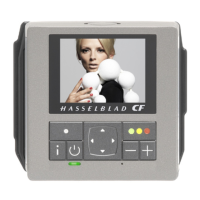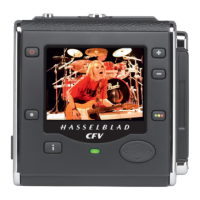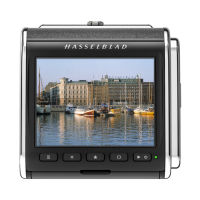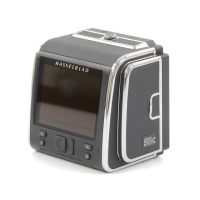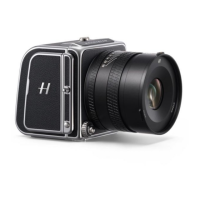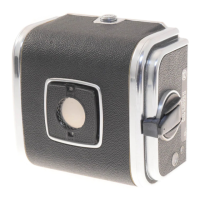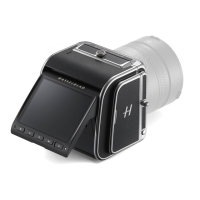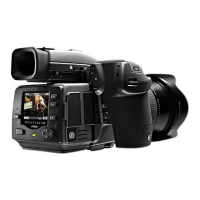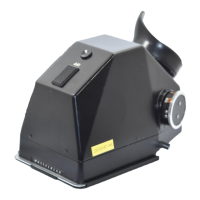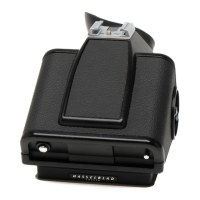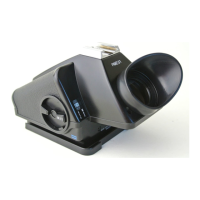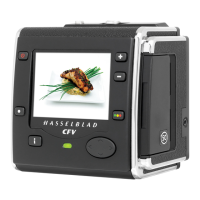
Do you have a question about the Hasselblad CFV and is the answer not in the manual?
| Brand | Hasselblad |
|---|---|
| Model | CFV |
| Category | Camera Accessories |
| Language | English |
Details hardware and software needed for image processing.
Precautions for safe operation and preventing damage.
How to select the menu language from seven choices.
Displays images, menus, and settings with high contrast.
Buttons for navigation, menu access, image approval, and zoom.
FireWire port, flash sync terminals, and ready light status.
Details on the CCD/IR filter and its protective cover.
Information on the required battery type for operation.
Steps for inserting and removing the power source.
Connecting the digital back to a computer via FireWire.
How to turn the digital back on and off.
Independent operation using a CF card for storage.
Connecting to a portable Imagebank for storage.
Direct connection to a computer for operation and storage.
Choosing the active storage location for images.
Step-by-step guide for handling CF cards.
Notes on using Hasselblad Imagebank with the CFV.
How to establish a FireWire connection to a computer.
Operating the CFV via FlexColor software.
Navigating and interacting with the CFV's menu interface.
Understanding the default screen showing image and setting info.
How to navigate through menu branches using buttons.
Using Zoom buttons to select values and confirm changes.
How to change the display language of the CFV.
Quick access methods for common menu commands.
Functionality and properties of batches for shot organization.
Methods for selecting current storage media and batches.
Visual interpretation of the media and batch list screens.
Step-by-step guide to selecting media and batches.
Procedure for creating new batches via the menu system.
Understanding green, yellow, and red status for images.
The typical process of taking shots and assigning status.
How to view and modify image approval status.
Filtering images displayed based on their approval status.
Methods for filtering images by approval status.
Options for deleting images based on their status.
Configuring the initial status assigned to new images.
How to view images on the display.
How to select a specific batch for viewing.
Filtering images based on their approval status.
Adjusting image magnification and view levels.
Detailed steps for magnifying images.
Using four or nine thumbnail displays for overview.
Cycling through display modes like Standard, Histogram, Full-screen.
Details of the default screen layout and information shown.
Interpreting histograms for exposure evaluation.
Enabling screen-off mode to save battery power.
Viewing images without interface elements.
Visualizing overexposed pixels in an image.
One-button method for deleting single images.
Moving images from CF card to a computer.
Moving images to an external hard disk in the field.
Structure and general interaction with the menu system.
Step-by-step guide for moving through menus.
Adjusting light sensitivity for exposure calculations.
Choosing the active storage location for images.
Filtering images by approval status (All, Red, Green, Green & Yellow).
Steps to delete one image at a time.
One-button method for deleting single images.
Procedure for formatting CF cards and Imagebank units.
Procedure for copying images to external media.
Steps for creating and naming new batches.
Setting the initial approval status (Auto, Green, Yellow).
Overview of settings related to language, display, and sound.
Details on Language, Power Down, Mark Overexp., Sound, Date & Time, Display.
Adjusting settings for different Hasselblad camera models.
Specific settings for ELX, Pinhole, Flash Sync, SWC, and 200 models.
Configuration for 500C/CM, 501C/CM, 503 CX/CXi/CW models.
Adjusting timing for camera synchronization and exposure.
Configuring multi-shot capture sequences.
Choosing how the camera appears to the computer (Camera or Disk).
Restoring factory default settings.
Connecting flash units for portable shooting.
Connecting flash units for studio use with tethered computers.
Using the TTL function with a 503CW camera.
Procedure for cleaning the sensor's IR filter.
Steps for cleaning the IR filter surface.
Using wet wipes for cleaning the IR filter.
How to clean the exterior surfaces of the digital back.
General advice on handling and maintaining the equipment.
Information on maintenance, warranty, and returns.
Environmentally friendly disposal guidelines.
